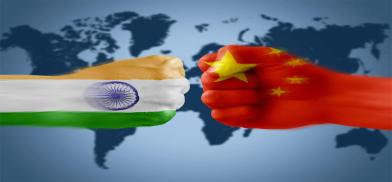China: Contextualizing the duality in actions
China never accepts deadlines on resolving disputes; in the decades to come it's going to be a hostile coexistence for India and China, write Pradeep S. Mehta and Sandra George for South Asia Monitor

In the recent past, the Chinese offensive has taken new shapes and attitudes towards India and the world. China is employing both offensive and defensive postures to build up as a dominant power in the world. This is particularly so in Asia as it does not want to share political space with India.
Just over the last 19 months, the skirmishes with India include the tussle in Ladakh, and around Sikkim and Bhutan. This is in addition to the mass incarceration of Uighurs in Xinjiang, a clampdown of democracy in Hong Kong, intrusion into Taiwanese airspace and unilateral actions in the South China Sea.
The primary way in which China has influenced many countries is through infrastructural projects. Fortunately, India is not a part of the Belt and Road Initiative (BRI). This is unravelling from infrastructure development into a debt trap to infrastructure offensive for many developing countries. This is evident in the case of Sri Lanka’s Hambantota port and Uganda’s Entebbe International Airport.
Clashes reflect economic disparity?
Historically, numerous disputes between India and China found resolution despite heavy contestations. This started changing by the early 1980s and a snarky shift has been observed by 2008.
For instance, India conducted a nuclear test in 1974 while China conducted the test in the 1960s. The condemnation and mobilization China undertook against India's nuclear tests in 1998 were drastically different from its response previously. This tendency continued on other occasions including when India requested to be a part of the Nuclear Suppliers Group (NSG), her attempt to finalize the seminal 123 nuclear deal with the US, and the attempt to list Maulana Masood Azhar as a terrorist through the UNSC committee.
Economically, India and China were more or less comparable till the 1980s. However, over the last few decades, China has witnessed rapid growth, taking it to near superpower status. The Chinese economy is over four times the size of India ($14 trillion vs $3 trillion) today. This disparity on the economic front for India is reflected in all other segments like diplomacy and military capabilities.
Democracy a challenge?
The realizsation of disparity seems to have raised questions on political systems. The political system of the two countries vary. India under a democratic state assures political rights for its citizens. China on the other hand was able to ensure economic growth. In net effect, an economic asymmetry exists between both countries. Does this imply democracy is the challenge?
Democracy is the considered legitimate form of political governance in the 21st century. This has been arrived at recognizing the political rights of the citizens. Does this imply trading off economic rights? Democratic conscience while guarantying political freedom is consistently trying to achieve the economic rights of citizens. Hence the focus should be on ensuring economic rights on par with political rights rather than tripping over the counter challenge.
There is no need for a special mention of the condition of political rights in China. Under Xi Jinping, this has taken a new turn ever since he got himself elected for life. The recurrent instances of Xi’s rivals or challengers going missing - the latest of the series being the Tennis star Peng Shuai. Curbing of cultural spaces includes the entertainment industry and reality shows. The opaque nature of the regime has not only had adverse implications on its home front but also the rest of the world. Especially, as there is an increasing need for cooperation to tackle the crisis of the commons.
Nature of Chinese diplomacy
The diplomatic engagement of any country is backed by its stature as an economic and military power. The exponential increase in economic power over the years has shifted Chinese diplomacy. Their willingness to stand alone, even in isolation, in preserving national interest is much more pronounced. This is displayed by the ‘Wolf Warriors’ in negotiations through aggression and arrogance.
One theme that runs through the diplomatic engagements of China is the use of grand deception as a legitimate strategy of diplomacy. This has been captured by former Foreign Secretary Vijay Gokhale in his work, “The Long Game: How China Negotiates with India?” In its engagements, China often employs ambiguity as a tool to deceive. The actions at the border region would be very different from the promises made by the leadership. Similarly, the written word is very different from the spoken word. Hence, China always leaves a question mark even before the event is over.
Chinese foreign policy, unlike Indian foreign policy, since early on has not at all been shy of armed confrontation. In cases of conflicts, negotiations are mere efforts to buy time. The typical Chinese strategy includes determining the venue, setting the agenda and planting public perception. Apart from these, the Chinese negotiators defend the party line, unlike other diplomats.
How China operates
The key imperative to Chinese foreign policy is it never accepts deadlines on resolving disputes. This long game needs to be understood by India in its engagements with China. In the decades to come it's going to be a hostile coexistence for India and China.
On the economic front, India is the world's youngest emerging economy with an average age of 29. This youthful workforce, which could be an engine of the world, can take over the role of China.
At the same time, the possibility of peaceful coexistence with China is long gone, what is awaiting is armed co-existence for India. Deterrence then becomes the only possible option. The formation of QUAD and AUKUS is promising in this multilateral deterrence framework.
At a bilateral level, India can cooperate with Russia, the US, the EU and other countries in the neighbourhood to deter China. There is no doubt that Russia and US are the strongest security partners for India. Unfortunately, India finds itself in a recurring loop on its bilateral engagements with US and Russia.
US foreign policy is set on ‘competitive engagement’ vis-à-vis China. Russia, on the other hand, recognizes the costs of a prolonged confrontation with Western powers and the dangers of relying solely on China. This leaves out India with two options: 1) India continues its policy of bilateral engagements with the US and Russia, while the latter acknowledge India’s geostrategic threat and do not interfere with India’s engagement with the other. 2) A trilateral dialogue with Russia-America-India. The contemporary international situation prompts such initiatives to ensure a free and open rules-based international order.
(The authors are associated with CUTS International, a global public policy research and advocacy group. The views expressed are personal.)










Post a Comment